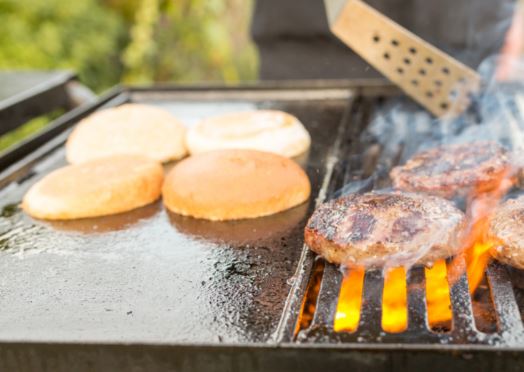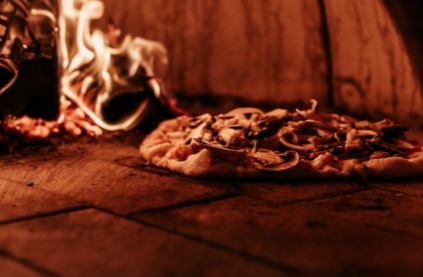What Else Can You Cook in an Outdoor Pizza Oven?
What Can You Cook in an Outdoor Pizza Oven?
Table of Contents
ToggleEven if you aren’t a good home chef, you may install a wood fired pizza oven in your yard or garden and enjoy cooking a family favorite next to an open flame. Furthermore, an outdoor pizza oven enhances your entertaining menu options. You can quickly customize pizzas to meet everyone’s preferences, whether you’re cooking for a small group or a huge gathering. But an outdoor pizza oven is not just a one-hit wonder.
An outdoor pizza oven can cook meats and chops, fish and seafood, breads, vegetables, poultry, sweets, casseroles, appetizers and snacks. If you can cook it in your indoor oven, you can probably cook it in your outdoor pizza oven in your outdoor kitchen.
Here is a small sampling of the types of foodstuffs that you can cook in your outdoor pizza oven other than than homemade pizzas:
apple crisp
baked brie
baked feta
baked or grilled fish
baked squash
biscuits
bread loaves
bundt cakes
carrot cake
casseroles
cheesecake
chicken wings
chili
cookies
corn on the cob
dips
egg rolls
fish sticks
flamed ribeye steaks
focaccia and flatbreads
fruit pizza
grilled shrimp
hamburger and hot dog buns
hot desserts
jacket potatoes
kabobs
leg of lamb
meatballs
paella
pasta casserole
pies
pot pies
potato chips
potato wedges
potatoes au gratin
pretzels
prime rib
pulled pork
quesadillas
quiche 40
roast turkey
roasted snapper
roasted vegetables
shrimp
slow cooked meats
smoked and barbecued meats
smores
soups
stews
strawberry rhubarb cobbler
stuffed peppers
Brick pizza ovens are a standout in an outdoor kitchen. They can stand alone at the far reaches of your yard (wood pizza ovens don’t need power so they can be located anywhere). They can also be deftly integrated into your outdoor kitchen cabinetry configuration. Because of their size and shape, they are a focal point wherever they happen to be located.
Interested in having a pizza oven in your backyard or outdoor kitchen? Read on to learn more about why pizza ovens do their jobs so well.
Pizza Oven Design
Building a perfectly functioning DIY or pre-manufactured outdoor pizza oven is a science. For appropriate air flow, the oven depth, height, width, and chimney placement must all be exact when creating any pizza oven. Second, high-temperature refractory materials capable of withstanding temperatures of more than 1200 degrees F. are required. Following these two easy principles will assure the functionality and longevity of a pizza oven.
The dome shape of a pizza oven is the optimal shape for the interior of the oven. The dome shape is intended to efficiently absorb heat from a wood fire while also evenly reflecting stored heat and heat from a live fire down to the cooking surface.
When choosing an oven opening size, you must weigh the ease of moving food in and out of the oven, as well as the size of pans, oven tools, and roasts that will be used, against the oven’s ability to contain and maintain heat. The larger the opening, the easier it is to operate with the oven, but the greater the heat loss. A small hole will allow your oven to maintain its temperature, but it will prevent you from utilizing a huge cast iron pan or a huge pizza peel.
What types of brick pizza ovens are there?
Wood-Fired Pizza Ovens
Wood pizza ovens provide a true wood-fired flavor that will leave you wanting more. However, you should expect a learning curve when it comes to creating a fire in wood fired ovens, and cleaning up afterward can be difficult.
A wood-fired pizza oven has pleasing appearance and makes your garden a pleasant spot to have a family gathering.
Pizza cooked in a wood-fired oven differs significantly from pizza baked in a standard oven in a number of ways. Because the oven is so hot, the pizza cooks in a very short amount of time. For a properly fired oven, that means 60-90 seconds.
In the end, the pizza comes out crisp on the exterior but chewy and juicy on the inside. The flavor and scent are scorched and deep.
The Advantages Of Using A Wood-Fired Oven
- The crust has a distinct flavor. The high heat caramelizes the crust, giving it a richer flavor. The smoke from the oven also imparts a smokiness to the pizza.
- The crust has improved. The steam with the extreme heat causes it to puff out swiftly. It stays light and chewy as a result of this. The outer layer, though, is still very crisp due to the heat. It has a distinctive brown speckled appearance that is very appealing to the eye.
- Cooking time is significantly reduced — 90 seconds versus 5-10 minutes.
- The toppings are cooked to perfection. If they’re lean toppings like vegetables, they’ll be charred. The cheese browns and bubbles as it cooks.
A pizza oven’s thick walls provide so much mass and insulation that it stays hot for a long period. It is sufficient to add a log every 20 minutes to maintain the greatest temperatures. It retains enough heat to cook low-temperature foods for up to 24 hours.
It takes at least an hour to reach your desired temperature, and it can be a little more difficult to maintain. Metal choices, on the other hand, have a faster heat-up time than brick ones and are less expensive than gas counterparts because there are no burner elements.
Furthermore, wood-fired ovens are enormous and heavy, requiring a lot of space. It’s also unsafe to use amid fire restrictions.
Gas Fueled Pizza Ovens
A knob is included on gas pizza ovens to make operating them adjustable. They heat up quickly and are much easier to adjust and maintain the temperature during the cooking process than brick ovens.
Cleaning this type is also a snap because there is no ash to pick up or a fire to prepare. Some types have a light and a viewing window, just like a regular kitchen oven.
Even better, a gas pizza oven with a wood chip smoker box allows you to give that delectable wood-fired taste to your cuisine.
How Does a Pizza Oven Differ from a Regular Oven?
There are restrictions to how rapidly your home oven can cook a pizza, regardless of how it is assembled. While a pizza shop’s ovens can reach temperatures of 700 to 800 degrees Fahrenheit, most home ovens are limited to roughly 500 degrees. Preheating the oven takes 20 to 30 minutes at that temperature, plus eight to 15 minutes to bake a pizza.
Higher temperatures—approximately 500 to 700 degrees—can be achieved with a wood fired pizza oven. This drastically reduces the amount of time it takes to cook a pizza. As a result, you can anticipate your pizza to cook in a wood-fired oven in just two to five minutes (depending on the dough thickness).
How Does a Pizza Oven Work?
Pizza is cooked in a brick oven using a traditional manner. Inside the oven, a fire is lit with wood or gas, and heat is generated inside the cooking cavity. The oven is designed to hold heat while also reflecting it across the cooking surface, resulting in a great browning effect and crispy crust. While preheating a brick oven can take up to 45 minutes, it can finally achieve temperatures high enough to cook a pizza in less than three minutes.
How Hot Does a Pizza Oven Get?
A classic wood-fired oven can cook at temperatures ranging from 850 degrees Fahrenheit (450 degrees Celsius) to 900 degrees Fahrenheit (900 degrees Celsius) (500C).
In comparison to a regular oven, the cooking temperature of a pizza oven used to cook and roast food can be substantially greater. It generates high heat more quickly, helping fruits and vegetables to preserve certain nutrients and antioxidants that would otherwise be lost if they were cooked for longer. The nutritional benefits of a wood-fired oven make your meals healthier, especially when you use it to make pizzas with a handful of vegetables for a taste explosion!
Aside from being able to cook food faster due to a higher amount of heat, the wood-fired oven also emits even heat distribution spreading out from the firewood and across the dome, increasing food flavor and giving it the smokey, delicious flavor you’ll crave.






